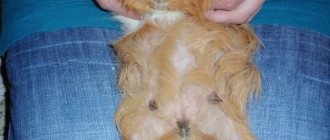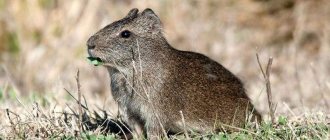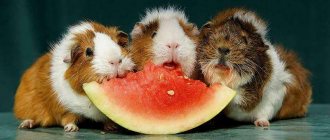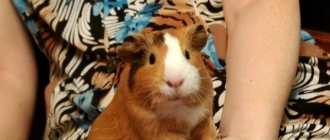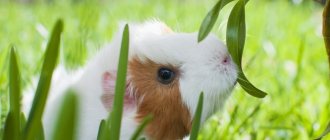Guinea pigs are far from silent creatures. They are very contactable and emotional. This is their special charm. They know how to convey emotions with a palette of melodic sounds. Over time, owners will be able to recognize the pig's tongue, but it is better to learn to understand the meaning of sounds as quickly as possible. Then it’s easier to make friends, and you can rest assured that your pet’s wishes are correctly understood.
Hums
Rumbling sounds can have a variety of meanings, depending on the position you are currently occupying. If the pig is currently feeling content and happy, then it will emit a guttural rumbling against the background of absolute relaxation and ease. However, if the rumbling sounds have a higher pitch, then the animal is most likely irritated by something. Tension in movements will also indicate this. If you take a closer look at the pet, you can see that it trembles while purring. But abrupt rumbling sounds clearly indicate that your pig is scared or feels uncomfortable.
Why does my pet whistle?
Often, when returning home, owners notice that their pet has risen on its hind legs and is whistling loudly. This is how the animal shows that it missed its owner and is glad to see him. Rodents also whistle when it's time for a snack. A hungry pig whistles when it sees a treat in its owner's hand or when it notices that the feeder is already empty. Owners who are annoyed by the constant whistling of a rodent are advised to put more food in the feeder so that the pet remains full longer and does not require supplements.
Squeals or whines
A squeal is a high-pitched squeak that unmistakably signals that your pet is feeling unwell and is overcome by fear and pain. If you hear this sound, be sure to check on your pets to make sure they are okay and no one was hurt. By whining or moaning, guinea pigs want to tell their owners about their irritation or dislike for something or someone, for example, their brothers.
Squeaks: all emotions in one sound
The squeak of a guinea pig has the largest range of values.
The reasons why your pet squeaks may be as follows:
- The animal was scared. In this case, the squeak is an involuntary reaction of the animal caused by fear.
- Newborn cubs squeak, expressing concern that they want to convey to their mother.
- Squeaking is chosen as a method of communication by males during the courtship period.
- If the animal is in pain, it squeaks.
- If there is an owner nearby who does not pay attention to the pet, the animal squeaks to evoke pity.
- Squeaking can mean indignation and protest. Animals love to spend time on their owner's lap. If you put them in a cage, they will squeak and be indignant that they were deprived of pleasure.
- Squeaking can mean a desire to get something. For example, when the owners sit down at the table and feed the pet at the same time. One day they won't do this, and he will squeak, begging.
- The pet may squeal with joy when it sees its owner entering the room. This expresses joy.
- A thin, plaintive squeak indicates that he would like to refresh himself.
Don't ignore the sounds of guinea pigs. The animal no longer has the opportunity to communicate its feelings.
Language of the body
Guinea pigs can also communicate through body language. If you understand this language, you will receive the keys to understanding what is happening to your pet.
When juveniles are particularly happy, excited, or in a playful mood, they like to jump up and down. Although this behavior is also typical for older representatives of the species. However, they don't jump that high.
Numbness often occurs at a moment of great surprise or doubt about something. Then she will stand still.
Sniffing is a way for guinea pigs to assess what is happening around them. In addition, this is how they recognize each other by sniffing the area around the nose, chin, ears or backside. And if they want to greet their brother in a friendly way, then they touch each other’s noses.
Showing aggression, a guinea pig tries to rise above its opponent, raising its head and standing on stiff legs. In addition, they sway menacingly from side to side, their fur stands up, and their mouth distorts into a grin. To enhance the effect, rodents can also hiss and grind their teeth. If you notice this behavior in your pets, be on the lookout. You may have to intervene in their relationship to prevent a fight.
If an animal swaggers, sways from side to side on stiff legs, and even grinds its teeth, this may be a sign of aggression. Although during the mating season, pompous behavior towards an individual of the opposite sex is an element of courtship.
Guinea pigs love to mark their territory. To do this, they rub their chin, neck or backside against the objects they want to get.
The desire to rise up manifests itself either during sexual relations between males and females, or at the moment of the formation of a hierarchy within the social structure of guinea pigs when kept in groups.
If your guinea pig is handled, it may show signs of anxiety and agitation. This may indicate that she wants to go to the toilet or that she is simply tired of playing with you. Be that as it may, you should return your pet, at least for a while, back to the cage.
Throwing back the head can be observed in spoiled guinea pigs at the moment of irritation. This way they can ask their owner to stop.
If a rodent begins to lick its owner, many consider this a sign of love. Maybe that's true, or maybe they just like the taste of salt on your skin.
They also love to be picked up by their owner out of their cage. Although at first the pigs show timidity, this is not at all because they do not want to play with the owner, but because a natural defense mechanism is manifested in them. It won't be long before she wants to cuddle up to you.
Article on the topic: A complete guide to the care and maintenance of a guinea pig
Decoding the movements of a guinea pig
As was said, it is easiest to decipher the sound signals given by pets if we consider them in inextricable connection with the movements of the animals. Body language, therefore, is no less important in the communication process than vocal communication, because the same sound, depending on the circumstances, can have not just different, but even opposite meanings.
Here are just a few characteristic movements of guinea pigs with their most likely interpretation:
| Movement, behavior | Possible meaning |
| Bouncing | "I want to play" |
| Throwing back the head | "I'm stronger, I'm not afraid of anyone" |
| Dropping of the head (may be accompanied by a low purring sound) | “Let’s put up, I give up, you are stronger” |
| Standing on the hind legs with the front legs extended forward | “Admire how good I am (good)” |
| Stand on your hind legs with your head stretched up | “I really want to reach something that is extremely necessary” (usually water or treats, but possibly toys) |
| Wide open mouth showing front teeth | "Better leave before it's too late" |
| Freezing in place, complete lack of movement | “I’m not here, go where you were going” |
| Paws tucked, searching for support behind the back | “It’s scary that something might happen” |
| Head stretched forward | “I’m all (entirely) attentive” |
There is a unique term in describing the behavior of guinea pigs - popcorning. It means a complex of characteristic body movements: the animal jumps, sometimes even somersaults, shakes its head, twitches its paws, twists its butt. This behavior can seriously frighten a novice breeder, but in fact it just means a high degree of disposition, excellent mood and a desire to frolic.
If an animal is stretched out in a cage or on the floor and does not make any sounds, then there can be no doubt about deciphering this behavior: the animal is well, it is peaceful and does not mind taking a quiet nap.
What to feed?
Guinea pigs are herbivores, so the basis of their diet should be hay. It should be in the cage at all times, just like water and food. Specialized food for such rodents can be purchased at a pet store. At the same time, you should avoid those that contain grain, as it is not absorbed properly in the animal’s stomach.
In addition to dry food, a guinea pig should receive two servings of fresh vegetables and fruits, as well as herbs daily - they are rich in vitamins and microelements and are vital. The optimal dose of succulent food is about 10% of the animal’s own weight daily.
Grinding/chattering of teeth
Why does a guinea pig chatter its teeth? Most often this is a bad sign. A pet can express its dissatisfaction and even anger in this way. If an animal makes hissing sounds by clicking its teeth or shows its teeth, then you can be sure that the animal is aggressive.
Grinding or chattering of teeth can be a warning sign of a fight. If pigs are kept together, they can arrange a division of territory or a showdown. It is better to accustom the animal to the neighborhood gradually. First, give the animals the opportunity to only hear each other. After a couple of weeks, the pigs can be placed in the same room. After some time, the rodents will be ready to live together.
When a pet has no conflicts with its relatives, and there are no obvious reasons for its anger, then it is worth checking the state of its health.
Rodents often chatter their teeth when they have an upset stomach.
Grinding can occur due to overgrowth of teeth, insufficient grinding of them on solid food and toys. A dental defect can cause infection or deterioration. Therefore, you should visit a veterinarian without delay.
Other reasons
In some cases, a furry rodent twitches and jumps for completely different reasons. To determine them, the owner should remember events related to the pet that could please him. The animal can rejoice at the received treat or fresh tasty grass. If he has recently been walked outdoors, this may also cause unusual behavior.
It may have to do with the conditions in which the animal is kept. A rodent cannot warm up if it is in a cramped room. He needs more space to play. Due to the lack of active movements, the pet lies on its side and twitches. To change the situation, a caring owner must increase the space by adding toys, wheels and tunnels.
What is necessary?
To ensure decent living conditions for your pet, you need to purchase the following equipment:
A cage. It should be spacious, since this is the animal’s only home. For one pig, its size should be at least 90 x 60 cm. It is advisable to keep guinea pigs in same-sex pairs, since they need communication with their relatives, so the optimal cage size for two animals should be at least 120 x 70 cm. Instead of a cage, you can use a rack or pen on the floor, but they must also be spacious enough and not resemble a punishment cell.
- A house or hammock for the animal to have its own shelter. Pigs are very shy, so they need a place where they feel safe.
- Feeder and drinker, which should be designed specifically for rodents. The feeder should be difficult to knock over, and there should always be fresh water in the drinker.
- Litter. For these purposes, it is prohibited to use cotton wool, paper or newspapers, as they can be very harmful to the animal. A thick layer of sawdust or pressed granules is used in combination with a PVC mat. You cannot use granules exclusively, as they can lead to problems with the animal’s paws.
The list of necessary things should include a carrier, which may be needed when visiting a veterinarian (rodent specialist - ratologist), a comb for long-haired breeds, as well as toys - balls, tunnels. By the way, it is forbidden to use a hamster wheel as a toy, since the pig’s spine is quite weak and is not designed for such loads. For the same reason, it is not recommended to use leashes and harnesses.
Variety of breeds
Species diversity is characteristic not only of dogs and cats, but also of guinea pigs. The photos demonstrate that there are both short-haired and long-haired breeds. The conditions of detention are the same for all, with the exception that long-haired dogs need to be combed and, in some cases, trimmed. The most popular breeds are:
- American Teddy;
- English self;
- satin;
- alpaca;
- skinny;
- Himalayan;
- Peruvian;
- Abyssinian;
- Sheltie;
- texel;
- crested.
They all have differences in coat type and color, as demonstrated by photos of guinea pigs. In addition, there are outbred smooth-haired and rosette pigs. Everyone is equally good-natured, trusting and timid, which makes them incredibly cute.
Chirps or tweets
The pig can not only squeak and purr, but also chirp and chirp like a bird. The feeling from such sounds is as if the pet is singing. Such sounds mean an extreme degree of excitement.
The pig sometimes chirps for up to half an hour, not noticing anyone around, immersed in an exciting state. This is how she experiences severe stress.
The expectant mother can thus announce to everyone around her that she will have cubs. The male can use his chirping to attract the female to mate. If two pigs are chirping among themselves, you don't have to worry. Nothing bad happens.
Contacting a veterinarian
However, sometimes an animal’s unusual behavior can also mean health problems. If the pet jumps around the cage, lies around, itches itself on everything, and the fur looks dull, begins to fall out and bald patches appear - this indicates the appearance of skin parasites. An animal can become infected with them not only by walking down the street. Often flea or tick larvae get to the animal along with low-quality hay or bedding, as well as poorly washed food. If your pig shows anxiety and loses his appetite, you should consult a doctor. Analysis of the skin scraping will determine both the type of parasite and the degree of infection.
Only a doctor can shorten teeth that have not been ground down
If all the conditions of keeping are met correctly, the pig receives a lot of attention and has a large living space, but suddenly it starts gnawing on cage bars or other objects - this may indicate problems with teeth or the presence of intestinal parasites. You can determine a worm infestation by carefully examining your pet's stool—most often, eggs or adult worms are found in the feces. For treatment, you can use Shustrik paste, which is sold at any veterinary pharmacy. If your pig has dental problems, then a visit to the doctor is a must.
Most often, in this way the animal tries to grind down excessively long incisors, which cause discomfort. In other cases, the animal tries to get stuck pieces of food or shows that its teeth are not properly rooted. Correcting a bite can only be done in a veterinary clinic. The procedure does not take much time and brings instant relief.
How to tame?
Why does my guinea pig squeak immediately after being brought home from the pet store? In this way, she can react to a change in environment and show fear. It is very important not to touch the animal in the first few days after acquisition, providing it with a large supply of food and water. Gradually, after the pig has settled in its new place, you can briefly pick it up and pet it.
You should not expect feline affection from a pig, as it does not become attached to people. However, the rodent remembers those who feed it and allows itself to be stroked. These animals are more suitable for observation than for affection. When the pig is completely accustomed to its new owners and does not feel dangerous around them, it will allow itself to sleep on the lap and lick the person’s fingers.
The gender of the guinea pig does not play an important role when choosing a companion animal, since their habits are very similar. The only nuance is that it is recommended to keep animals in same-sex couples in order to avoid the appearance of unwanted offspring.

